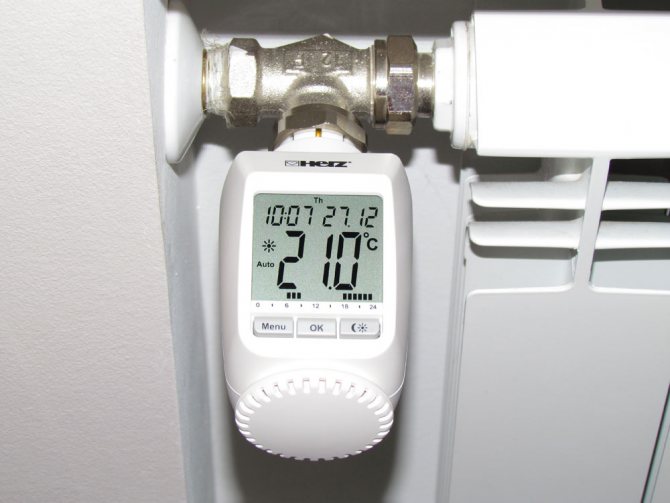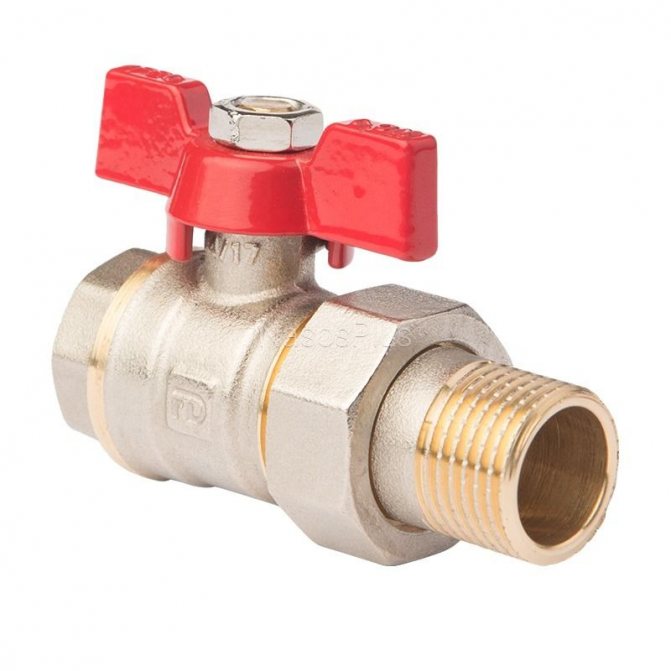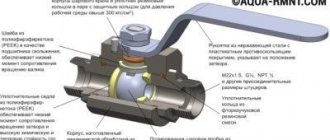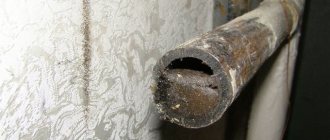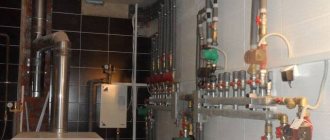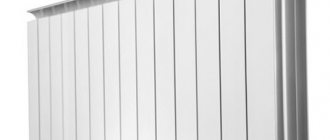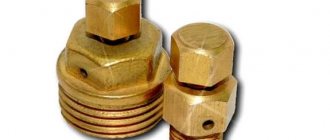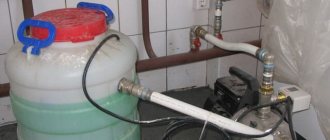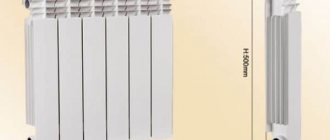Ball valve
This is the most famous type of valves. Inside it there is a smooth ball that has a through hole and is able to rotate 90 ° C, thus, regulating the flow of water in the pipe, blocking or opening it. The design of the mechanism provides it with minimal resistance to flow in the open state. It is designed to operate in a fully open or fully closed position to quickly shut off or drain water in some cases. Intermediate provisions are possible but prohibited.
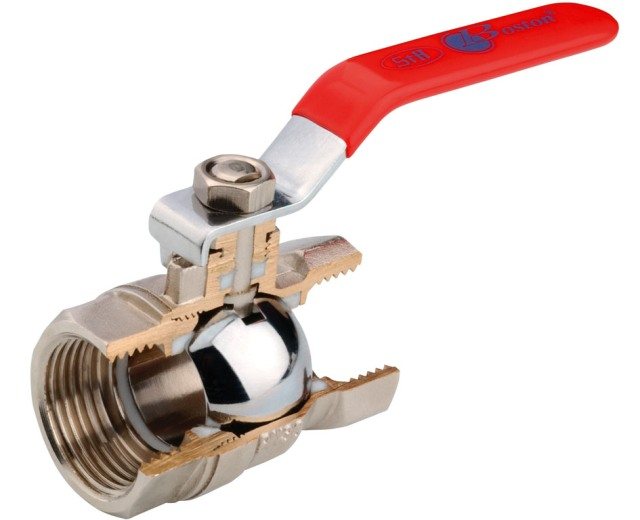
The materials for these mechanisms will be nickel-plated brass and stainless steel, and polymer materials are also used for metal-plastic systems. There are expensive and high-quality Danfoss, Giacomini, Bugatti cranes on the market. For limited financial opportunities, Chinese and Turkish Valtec, Fado are offered. Good quality at a low price is offered by the Chinese AGUA-WORID.
The most common type of faucet is a valve. Allows you to adjust the pressure. The channel for the flow inside it is perpendicular to the fluid flow in the supply pipes. Installation must be carried out with careful consideration of the markings so that the water flows in only one direction.
There are valves with conical valves for heating systems. They are most effective for these conditions. Fully open, it allows the maximum amount of liquid to pass through, which makes the heat transfer of the battery more efficient. The mechanism allows you to reduce the flow of the coolant and reduce heat transfer if the room is too hot and, thus, to control the temperature.
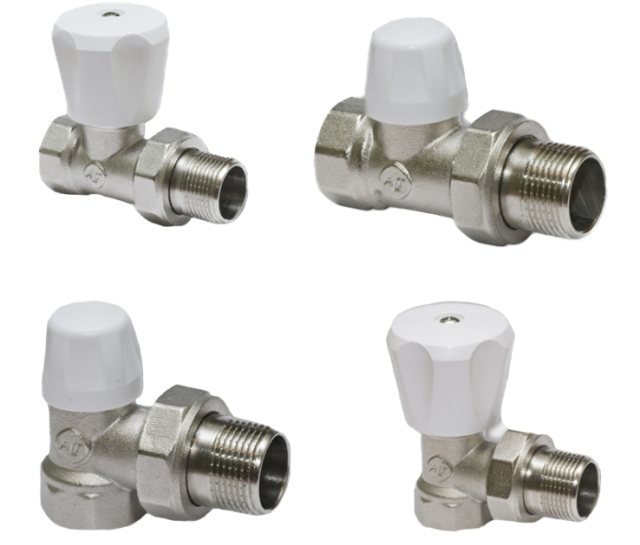

There are such types of them:
- adjusting (straight and angular). They have manual control. They are used in autonomous heating. They cannot accurately adjust the heat transfer due to the lack of a scale and a temperature sensor;
- equipped with a thermal head. Their design allows blocking or limiting the temperature rise through manual or automatic control. Installed on two- and one-pipe systems. Adjustment is simple - the required temperature is set manually using a limit ring;
- with thermostat. Installed in front of the battery. The flow of the coolant is controlled by a valve mounted in front of the thermostat.
There are no plastic valve taps, they are made of brass, steel or a combination of these materials.
Water taps
Appointment of equipment
Taps, which are mounted on heating radiators, are needed not only to block water access to equipment.
They do many other, no less important tasks:
- regulate the temperature of the radiator by limiting the volume of warm water pumped through the battery;
- remove air plugs from the heating system, which greatly reduce the efficiency of its work;
- are used for filling and discharging the coolant not only in heating batteries, but also in the pipelines connecting them;
- can be used to shut off the heating network in case of an accident, planned or emergency repair.
Based on the above tasks, it is directed to highlight the following types of cranes:
- To disconnect the main pipeline, a section of the heating network or a separate device. With their help, it is possible to turn off the water in the event of an accident or repair.
- For adjusting the volume of flowing water. In this case, in addition to the "on" and "off" modes, there must be others.The ability to set the temperature in the house depends on how accurately the tap can set the amount of the supplied coolant.
- To discharge gas or water. In the first case, the valves help to get rid of air congestion, in the second - to remove fluid from pipes and radiators, after which it is possible to inspect and replace them.
Installation locations
Regardless of the name, a tap for a heating radiator can be mounted not only on the specified equipment, but also in other places (depending on the functional purpose):
- at the entrance of the central heating main to the basement of the house - they open and close at the beginning and at the end of the heating season;
- to the bypass (a pipe passing between the inlet and outlet of the battery, which supplies the direct flow of the coolant) - here the control valves are needed to reduce or increase the volume of the flowing liquid and switch the forced network to natural circulation;
- on risers - quite often such cranes are mounted at the entrances to apartments in multi-storey buildings and are allowed to repair the local climate network without shutting down the entire system;
- on the battery nozzles - their main purpose is to regulate the air temperature, therefore automatic thermostatic valves are appropriate here;
- in places where an air lock may appear, Mayevsky's taps are installed here, which help to bleed air that accumulates when the system is filled with a coolant or during its operation.
Note! The use of valves controlled by automation allows, without human intervention, to dose the amount of water entering the battery and remove the accumulated air space from the system. There is only one drawback of such solutions - a high price.
Applicable materials
The highlight of the shut-off and control valves installed in heating systems is its constant contact with the coolant, the chemical and physical composition of which is often not encouraging.
Based on this, the material used in them must be resistant to corrosion and withstand well the mechanical action of abrasive particles, which are seen in the fluid circulating through the pipes.
Cranes made of the following materials are much more often used:
- bronzes - are attached to pipelines by means of special fittings;
- polypropylene - installed on polymer pipes by soldering.
Advice! In some hardware stores, it is possible to find silumin cranes. They are similar to brass but cost much less. Their level of quality, strength and durability is low, therefore, such fittings should not be used for the construction of engineering networks.
Varieties of cranes
All existing cranes are divided into two groups:
- Locking. They are straight and angular. They are mounted on heating radiators and are used to block access and regulate the volume of warm water entering the batteries. Their use makes it possible to protect the heating panel from hydraulic and pneumatic shock that appears during the filling of the system with a coolant. In addition, they allow you to disconnect a particular battery and carry out its repair, cleaning or replacement. They are easily attached to the batteries by means of a pipe thread, forming a fully sealed connection. They withstand strong liquid pressure well and have an attractive appearance.
The disadvantage is the impossibility of narrow regulation of the room temperature. Quite often they are used in autonomous heating systems, where mode switching is carried out using the boiler control panel.
- Thermoregulatory. The tap contains a special flexible container filled with liquid or gas. When heated or cooled, it, respectively, increases or decreases significantly, regulating the access of water to the battery and, thereby, the temperature.There are two types of thermostatic valves:
- with manual control - in this case, you turn the knob and set the temperature yourself, focusing on the numbers that are printed on the valve body;
- automatic - in this case, the room temperature is controlled by a microchip depending on external conditions (data provided by special sensors are used).
The advantages of the latest type of crane are obvious:
- the ability to transform the temperature of the batteries depending on weather conditions;
- saving the coolant due to a narrower adjustment of the operation of climatic equipment;
- protection against freezing of the coolant with a sharp drop in the outside temperature.
Locking mechanisms classification
Heating taps are classified according to one more indicator - the design of the shut-off device.
They are:
- ball (flanged) - can only be connected and disconnected, there are no intermediate options;
- conical - allow you to close the hole for the water flow, open it and put the valve in intermediate positions;
- automatic - control of the volume of the flowing liquid is regulated by means of special electronics.
Flanged valves are much more often installed on pipelines. This is due to the fact that their design is able to withstand high fluid pressure. They will be able to serve reliably for a long time.
As for the radiators themselves, conical products equipped with couplings are used here. The presence of the thread makes it possible to tightly secure the control valves to the inlet and outlet branch pipes of the battery, and the conical locking mechanism allows you to more accurately regulate the amount of incoming water.
Selection and installation of radiator valves
Connecting heating devices using correctly selected shut-off and control valves improves the functionality of the heating system and makes operation more convenient. The faucet for the heating radiator must be made of quality materials and properly installed.
The fittings for heating radiators are divided into shut-off (blocking the flow of the coolant) and regulating (designed to control the flow rate). The valves are only shut-off valves, the control valves are valves and gates. But in everyday life, taps mean all types of shut-off and control valves.
Installation of cranes
The installation scheme depends on the type of selected shut-off and control valves.
Crane installation process
The following mounting options are most common
:
- In a one-pipe central heating system, 2 ball valves are placed between the radiator and the bypass - on the inlet and outlet pipes. This makes it possible to leave it filled when draining the coolant from the system during the network repair period, disconnect or dismantle the battery for painting, cleaning, replacement.
- In an autonomous two-pipe system, a thermostatic valve is placed on the supply pipe, and a balancing valve is placed on the return pipe, which will be responsible for maintaining normal operating pressure.
- In a stand-alone one-pipe system, a ball valve can be installed on the supply pipe, and a control valve on the return pipe. If the valve has a function to cut off the coolant flow, a second ball valve for the radiator is not required.
Installation of ball valves
Ball valves, which are installed on a heating radiator, have two operating positions: "open" and "closed". Partially blocking the flow of the coolant using this type of fittings is prohibited. As a result of improper use, the device may fail and begin to leak.
The device can be straight or angled - the choice depends on the system layout.If the installation of regulators is not provided between the shut-off valves and the radiator, the ball valve may be installed directly on the heater using a squeegee - a special additional part.
Before installation, make sure that the parameters of the device (operating pressure, maximum permissible temperature of the medium) correspond to the characteristics of the heating system. The direction of flow is indicated on the valve body - installation is carried out in accordance with the mark.
| Share on social networks: | Rate the article: |
Source: isanshop.ru
Ball valve
This is the most famous type of valves. Inside it there is a smooth ball that has a through hole and is able to rotate 90 ° C, thus, regulating the flow of water in the pipe, blocking or opening it. The design of the mechanism provides it with minimal resistance to flow in the open state. It is designed to operate in a fully open or fully closed position to quickly shut off or drain water in some cases. Intermediate provisions are possible but prohibited.
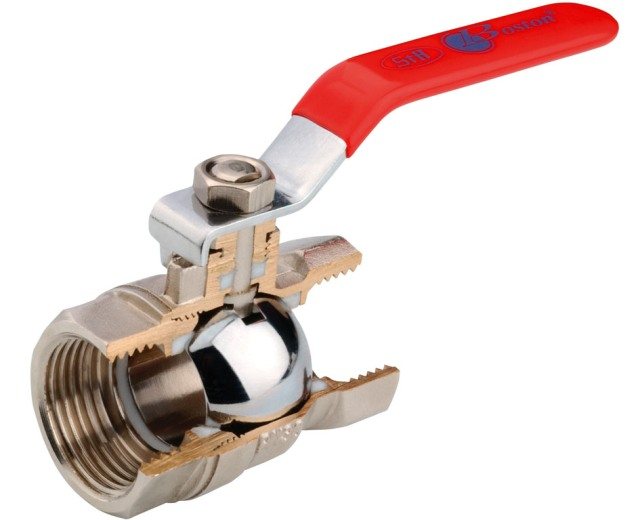

The materials for these mechanisms will be nickel-plated brass and stainless steel, and polymer materials are also used for metal-plastic systems. There are expensive and high-quality Danfoss, Giacomini, Bugatti cranes on the market. For limited financial opportunities, Chinese and Turkish Valtec, Fado are offered. Good quality at a low price is offered by the Chinese AGUA-WORID.
The most common type of faucet is a valve. Allows you to adjust the pressure. The channel for the flow inside it is perpendicular to the fluid flow in the supply pipes. Installation must be carried out with careful consideration of the markings so that the water flows in only one direction.
There are valves with conical valves for heating systems. They are most effective for these conditions. Fully open, it allows the maximum amount of liquid to pass through, which makes the heat transfer of the battery more efficient. The mechanism allows you to reduce the flow of the coolant and reduce heat transfer if the room is too hot and, thus, to control the temperature.


There are such types of them:
- adjusting (straight and angular). They have manual control. They are used in autonomous heating. They cannot accurately adjust the heat transfer due to the lack of a scale and a temperature sensor;
- equipped with a thermal head. Their design allows blocking or limiting the temperature rise through manual or automatic control. Installed on two- and one-pipe systems. Adjustment is simple - the required temperature is set manually using a limit ring;
- with thermostat. Installed in front of the battery. The flow of the coolant is controlled by a valve mounted in front of the thermostat.
There are no plastic valve taps, they are made of brass, steel or a combination of these materials.
Types of heating systems and the principle of regulating radiators
Valve handle
In order to properly adjust the temperature of the radiators, you need to know the general arrangement of the heating system and the layout of the coolant pipes.
In the case of individual heating, regulation is easier when:
- The system is powered by a powerful boiler.
- Each battery is equipped with a three-way tap.
- Forced pumping of the coolant was installed.
At the stage of installation work of individual heating, it is necessary to take into account the minimum number of bends in the system. This is necessary in order to reduce heat loss and not reduce the pressure of the coolant supplied to the radiators.
For uniform heating and rational use of heat, a valve is mounted on each battery.With it, you can reduce the water supply or disconnect it from the general heating system in an unused room.
- It is impossible to adjust the radiators in the central heating system of multi-storey buildings equipped with a coolant supply through a pipeline from top to bottom. In this situation, the upper floors open windows due to the heat, and in the rooms of the lower floors it is cold, since the batteries are barely warm there.
- Better one-pipe network. Here, the coolant is supplied to each battery with its subsequent return to the central riser. Therefore, there is no noticeable temperature difference in the apartments of the upper and lower floors of these houses. In this case, the supply pipe of each radiator is equipped with a control valve.
- A two-pipe system, where two risers are mounted, provides a coolant supply to the heating radiator and vice versa. To increase or decrease the coolant flow, each battery is equipped with a separate valve with a manual or automatic thermostat.
Types of heating systems
Today there are a fairly large number of types of heating systems. Each of them has its own characteristics for connecting radiators. Undoubtedly, if you decide to involve a master to install the batteries, he knows all this. But if you plan to install radiators yourself, then you need to distinguish between the types of connection of heating radiators - after all, you need to know which system will function in your home.
One pipe system
This type of heating is common in multi-storey buildings. The ease of planning and installation, as well as the minimum amount of materials used, make it very profitable.
In this case, the heat transfer of the system is calculated even when creating a heating project, and in the future it fully corresponds to the specified parameter.


One-pipe heating system
Two-pipe heating
The principle of operation of this heating system is simple - a heated coolant is supplied to the battery through one circuit. And the outflow of the cooled coolant is carried out along a different circuit. All heating devices in the system are connected in parallel. A significant advantage of a two-pipe heating system is that it is possible to control and, if necessary, adjust the heating level. To do this, special valves are placed on a two-pipe connection of heating radiators - on a separate radiator
It is important to remember that when connecting radiators, it is necessary to strictly follow all the rules specified in SNiP 3.05.01-85
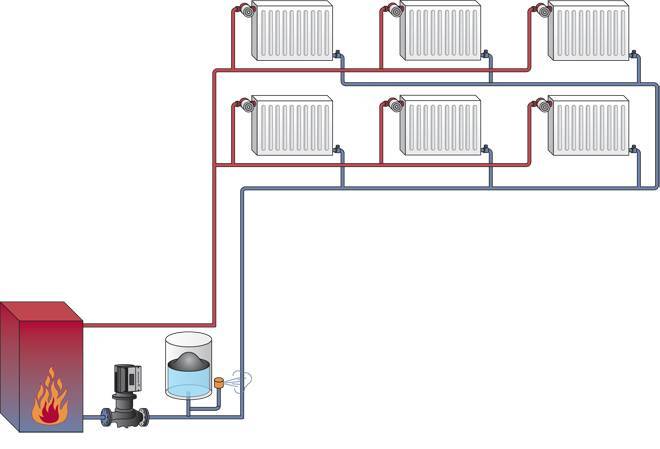

Two-pipe heating
Types of materials used
When deciding which tap to put on a heating radiator, you should pay attention to the material of its manufacture. First of all, the main requirement for the material is its anti-corrosion properties.
Most often, synthetic brass is used for production, and products made of high-quality polypropylene are also popular. The top layer can be additionally protected by metal spraying.
The types of fasteners differ depending on the material. So, a brass faucet is attached using a fitting or thread to pipes made of plastic or metal. To install a polypropylene valve, you will need to select a welding method.
Useful information for those looking to choose a universal locking device
Battery valve
Choosing a tap for a radiator
it is important to pay attention to the material from which it is made. The locking device works in the most aggressive environment. It is constantly in water, exposed to high temperatures and water shocks
Therefore, it is important that the material can withstand all these negative factors.
It is constantly in water, exposed to high temperatures and water shocks
Therefore, it is important that the material can withstand all these negative factors.
Most often, faucets for radiators are made of alloys. Most of the models are made of brass. It is a very durable metal that is not afraid of corrosion. But for even greater strength, the brass is coated on top with a protective metal compound. This is the best option for heating applications.
Sometimes, instead of brass taps, sellers can slip a fake of them - silumin control valves, which outwardly, like two drops of water, are similar to the original models.
After a year of operation, breakdowns often occur that can lead to utility breakdowns. After all, from the inside, the silumin rusts very quickly, and corrosion instantly corrodes the body, making its walls very thin. Therefore, any water hammer easily ruptures the locking device. Even if this does not happen, there are often cases when, by simply opening or closing the tap, it simply remains in the hands of a person, falling off the base. If there is hot water inside the battery at this time, burns will certainly occur. So beware of counterfeiting!
So, the tap for the heating battery must necessarily be made of brass - only this alloy easily tolerates high temperatures and water hammer. It is better to choose ball locking mechanisms that have high warranty periods and demonstrate increased tightness. Such a crane can be installed both horizontally and vertically.
What other taps are suitable for radiators
When the radiators are being installed, the question naturally arises, which control valve is better to choose. Experts recommend giving preference to conventional ball locking mechanisms. But do not forget that each radiator must be equipped with one more element - a needle valve, also known as the Mayevsky valve. What is this device?
Typically, a similar plumbing fixture is used in order to bleed air from the battery. The heating medium in the central network always circulates unevenly. Air enters the system along with hot water. It forms bubbles, and if the pressure of the coolant drops, an air lock forms in places of its especially low speed, which sharply reduces the heating efficiency. The Mayevsky valve helps to eliminate it. It is mounted at the top of the radiator.
How does such a control valve work?
Crane device
Its central mechanism is a needle valve. This assembly can be moved using a wrench or a locking screw. It has a square head that fits easily into existing grooves. If the key is not at hand, a screwdriver can be used instead.
A valve is installed on the opposite side of the coolant inlet. The air that has accumulated inside the system rises and collects at the highest point of the radiator, where the control valve is installed. If the system has a Mayevsky valve, the airlock can be easily removed by opening the needle valve. It is simply turned counterclockwise a few turns to produce the characteristic hiss. As soon as it stops, turn the valve back and close the valve tightly.
The air will escape to the outside through a special hole. It can be located either in a plastic gasket or in the brass body itself. Both varieties serve equally reliably and efficiently. However, if the quality of the coolant leaves much to be desired, the described hole clogs up very quickly. Therefore, experts recommend periodically piercing it with a regular sewing needle. This can only be done with the valve closed.
When the pumping equipment is on, it will not be possible to bleed the air lock. Water can flow through the valve under pressure, making it difficult to avoid a flood.
Automation in the service of man
Automatic faucet
Manufacturers are constantly striving to improve their products and offer consumers new generation locking mechanisms. The usual Mayevsky control valve was no exception. It was finalized and equipped with the simplest automated system.
The new know-how looks like a conventional tap that is installed on a radiator. And the principle of the locking mechanism remains the same. But if air accumulates in the upper part of the radiator, a special needle float is lowered, the valve opens, and the air is released on its own without human intervention. Very convenient, isn't it? No need to pick up a screwdriver and no need to constantly monitor the condition of the radiators. I put on the tap and forgot about it.
But the inlet for the key and screwdriver is still provided in such a plumbing fixture. Cases are different, and sometimes you have to act the old fashioned way, bleeding the air manually.
Where can a Mayevsky crane be installed?
As a rule, the described device is easily installed on all modern types of radiators. But consumers want to know if such a locking mechanism can be used when only cast iron batteries are available.
The automatic version cannot be used in this case. After all, the cast-iron walls, although over time do not rust, but inside they constantly crumble and become covered with mucus. This makes the coolant very dirty.
Installing the device on a radiator
The central system is not equipped with purification filters, and to maintain the required temperature, public utilities add chemical compounds to the water, which also deteriorate the quality of hot water. Automation in this situation fails very quickly. Every month you will have to remove Mayevsky's tap and clean it by opening the air hole. This activity is very tedious, so the goal does not live up to expectations.
Therefore, it makes sense to use Mayevsky taps only when assembling autonomous heating. On a cast iron radiator connected to the central system, it is better to put brass ball valves that it releases. They are able to withstand harsh operating conditions. Laboratory tests have shown that brass valves can safely withstand water shocks up to 15 atmospheres.
Functional purpose
Why equip a radiator with taps? Their installation when connecting heating devices makes it possible
:
- completely turn off the radiators if, for some reason, the room does not need to be temporarily heated;
- shut off the coolant supply for flushing or revising individual radiators without draining the coolant from the entire system;
- regulate the intensity of heat transfer from the batteries in manual or automatic mode, maintaining a comfortable temperature regime in the room;
- remove air pockets from radiators, increasing system efficiency and reducing the risk of metal corrosion.
Application
With the help of various types of shut-off valves, it is possible not only to completely turn off a separate section of the system for repair work, but also to change its configuration. The permeability of the coolant is controlled by manual or semi-automatic valves. Thanks to them, you can change the temperature in the radiators. Shut-off and control valves make it possible to discharge air or coolant in the system, shut off the water supply to the heating device.
Such mechanisms make it possible to multiply the efficiency of the heating system both in a private and multi-storey building.
Types of control valves
Existing modern technologies of heat supply make it possible to install a special tap on each radiator to control the quality of heat. This control valve is a shut-off valve heat exchanger that is piped to the radiator.
According to the principle of their work, these cranes are:
Ball, which primarily serve as 100% protection against emergencies. These shut-off devices are a design that can rotate 90 degrees, and can pass water or obstruct the passage of the coolant.
The ball valve must not be left half-open, as this could damage the O-ring and cause leakage.
- Standard, where there is no temperature scale. They are represented by traditional budget valves. They do not give absolute control accuracy. Partially blocking the access of the coolant to the radiator, they change the temperature in the apartment by an undefined value.
- With a thermal head, which allow you to adjust and monitor the parameters of the heating system. Such thermostats are automatic and mechanical.
Conventional direct thermostat
A direct-acting thermostat is a simple device for controlling the temperature in a heating radiator, which is installed near it. By its design, it is a sealed cylinder, into which a siphon with a special liquid or gas is inserted, which clearly responds to changes in the temperature of the coolant.
When it rises, the liquid or gas expands. This leads to an increase in pressure on the stem in the thermostat valve. He, in turn, moving, blocks the flow of the coolant. When the radiator cools down, the reverse process takes place.
Temperature controller with electronic sensor
The principle of operation of this device does not differ from the previous version, the only difference is in the settings. If in a conventional thermostat they are performed manually, then the electronic sensor does not need this.
Here the temperature is set in advance, and the sensor monitors its maintenance within the specified limits. The electronic thermostatic sensor regulates the control parameters of the air temperature in the range from 6 to 26 degrees.
Mayevsky crane
In addition to water taps, air taps are mounted on heating batteries. They are called Mayevsky cranes. They help to remove air that inevitably forms in pipes and radiators during the operation of the system. The installation instructions for heating systems provide for the installation of such devices at the top of each heating panel.
Operating principle
The main element of the Mayevsky tap is a needle air valve. This mechanism can be driven by a special key or a simple screwdriver.
The air valve must be mounted on the side of the radiator opposite from the inlet valve. As the coolant is poured, the air space in the battery rises and accumulates in the far upper corner of the device. There, a tap is installed through which the emerging airlock is released.
The procedure for working with the Mayevsky valve is simple: it is necessary to unscrew the screw until a hissing sound appears, which is emitted by the emerging air space. When water appears from the intended hole, it is possible to close the valve.
The valve can have a polymer body or be made of bronze. Both of these options are completely reliable. It is only necessary to ensure that the outlet of the air valve is not clogged with hard particles, which from time to time are seen in the coolant. It is possible to clean it with a simple needle.
Advice! If your home is equipped with a heating system with forced circulation, then before removing the air lock using the Mayevsky crane, you need to turn off the pumping equipment. Otherwise, warm water will flow too quickly and the air space will not have time to accumulate in the upper part of the radiator.
Automatic air valves
Any manufacturer of plumbing equipment is trying to produce equipment that regulates certain parameters of the operation of engineering networks without human intervention. This also applies to air valves, which remove plugs from radiators and heating pipes.
Mayevsky's involuntary crane from the outside does not actually differ from its progenitor. In addition, the principle of its functioning has not undergone any transformations. But, a special mechanism automatically opens the valve when the air pressure in the battery rises above the set value.
So, the installed involuntary air valve will save you from the need to periodically check the heating system for detecting air congestion and manually removing them.
Features of the installation of automatic Mayevsky cranes
This device can be mounted on virtually all existing radiators. But the owners of the widespread cast iron batteries will have to be disappointed. Mayevsky's crane will not help them cope with the air in the climate network.
This is affected by the following events:
- The internal surfaces of a cast-iron radiator during operation are slowly covered with rust, the particles of which come off, enter the coolant and can clog the bypass hole of the automatic air valve.
- The central water supply system, of which cast-iron batteries are part, is not equipped with filters that trap solid particles in the heat transfer fluid. In addition, quite often various aggressive chemicals are added to the water, which, in addition, adversely affect the operation of the air valves.
- Radiators connected to the municipal heating system are often drained during the summer. Based on this, at the end of the filling of the system, too large plugs can appear, which will not be bleed through the 2-mm hole. We'll have to use more effective methods.
Note! All the advantages of Mayevsky's automatic cranes are revealed only when designing autonomous control systems, where it is possible to control the quality of the coolant, its temperature, pressure and other, no less serious operating parameters.
Risers and a valve that cuts off heating sections
In this case, the recommendations of specialists do not differ in the originality of the solution, since cork valves are considered the best choice. In the risers, it is necessary to create conditions for the discharge of the coolant and for this purpose, plugs are chosen, but they are not always convenient, since it will be quite problematic to unscrew the plug on the supply riser through which a water flow circulates with a water temperature of about 90 degrees.
As a result, the conclusion is obvious: valves should be installed to discharge water.
In this situation, screw devices can be used, since they will not have significant disadvantages:
- if the gland is installed correctly, it will not have contact with the water flow under pressure;
- water hammer becomes impossible, since the valve is mostly closed;
- to replace the gaskets, you do not need to reset the entire house system - just stop the riser.
Elevator unit
In apartment buildings at the entrance and exit from the elevator unit of the heating system. as a rule, valves are mounted. In their body there are two rings of corrosion-resistant steel that surround the passage for the coolant (mirrors). A couple more mirrors are located on the surface of the valve - its movable part.
When the damper is in the lower position and lowers, it blocks the movement of water, but if it moves to the upper position, it goes beyond the circulating flow.To close the valve, the consumer needs to rotate the handwheel, which drives the rod, which has a screw thread. A gland packed around the stem will help ensure tightness. For heating and hot water, the product must be graphite. There is no alternative to this device with a pipe diameter of 50 millimeters. It is necessary to determine which are the best taps for heating radiators.


If this parameter is lower, it is recommended to use modern plug valves, such as in the photo, since the valves have serious drawbacks:
- it is necessary to periodically fill the gland, even if the valve is not used, since the packing, in contact with water, gradually collapses;
- after a short period of time, the cheeks begin to overgrow with deposits. If the valve is left unused for several years, it will not be possible to completely close it;
- in case of emergencies, every second can be decisive. If it takes literally a moment to close the plug valve, then it will take a long time to rotate the handle of the valve, even when it is completely serviceable.
It should be noted that cork valves, which are a ball with a water channel surrounded by a plastic sheath, are different:
- practicality;
- durability;
- reliable fluid retention;
- lack of need for maintenance.
Plumbing experts do not recommend purchasing and installing a screw valve on a radiator or the same products of any other type.
They have significant disadvantages of the design solution:
- the gland will need to be filled periodically if there is no desire to put up with a constant leakage along the stem. When it is difficult to replace the valve or fill the gland, then to eliminate the leakage, the valve must be opened to failure with little effort. The leakage will stop due to the fact that the thread on the stem will press the oil seal:
- rubber gaskets for heating elements have a limited shelf life. A valve for a heating radiator with flat brass valves does not hold water after a certain time due to the appearance of deposits on the valve and seat. The same shut-off elements with wedge-shaped brass valves, after closing them with effort, often wedge in the saddle;
- all screw valves are installed only along the water flow. For orientation, a pointer is depicted on the case of many products. The installation of the valve against the water inflow will certainly end with the valve tearing off and then blocking the water tightly.
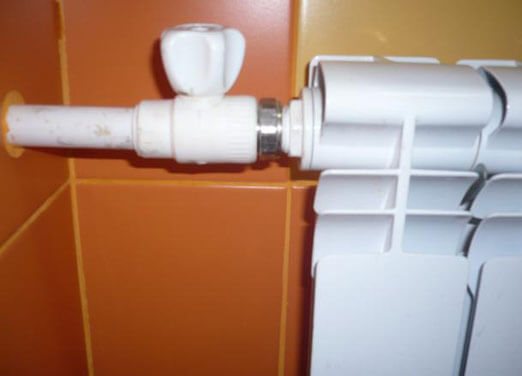

Another undesirable prospect is associated with the operation of the valve - the possibility of water hammer if the valve is not completely closed and turbulence arises in the water flow, periodically closing the seat. Water hammer
- these are short-term pressure surges, as a result of which the weakest parts of the heating circuit are destroyed.
Helpful tips for choosing
Several features are described below in order to determine which products are best to use.
Locking mechanism
Thermostats have two types of locking mechanism: a valve and a valve with a cone (stem). The latter is preferred, it allows for smooth adjustment. The temperature is manually set using a stop ring mechanically. There are also electronic mechanisms, they are more autonomous.
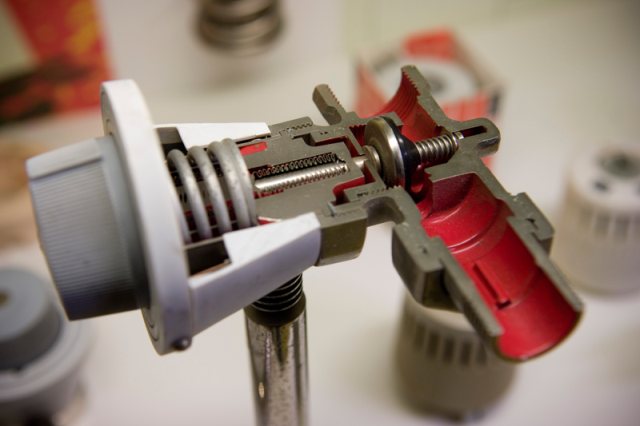

It is better to install ball valves than valves, which have a number of disadvantages: the gland will wear out faster, overgrow with deposits, and close for a long time. Disadvantages of the Mayevsky crane: low permeability, it requires a special key or a screwdriver, which is inconvenient to use. If you accidentally twist its stem, it is very difficult to twist it back, overcoming the pressure of the water. Instead, it is recommended to install a conventional valve or special automatic radiator air vents.The optimal and affordable option if temperature control is required is a faucet with a thermal head.
Housing and connections
It is better to install on batteries not standard ball valves, but full bore. In residential, houses and apartments, such mechanisms with a sleeve connection are used.
It is better to choose faucets for heating radiators with a steel or bronze body, but most often they use brass ones, since they are cheaper. The imitation brass is silumin. It is not worth buying a product made from it, it is a very soft metal. Polymer materials are no less reliable, but they have large dimensions. To replace them, you need to cut a piece of pipe.
Products with polymer rather than rubber gaskets are more durable. Taps for adjusting the coolant on heating radiators exclude the possibility of changing them without draining the water, this can be done with straight-through taps or with an American installed (towards the battery).
Products of the firm Itap (Italy), Danfoss are considered to be of the highest quality. The approximate price range is 700–2000 rubles. In the middle price range, there are products of the Oventrop brand - 550–950 rubles. For a limited budget, Luxor is suitable - 450-800 rubles. Chinese or Turkish stamps.
Helpful tips for choosing
Several features are described below in order to determine which products are best to use.
Locking mechanism
Thermostats have two types of locking mechanism: a valve and a valve with a cone (stem). The latter is preferred, it allows for smooth adjustment. The temperature is manually set using a stop ring mechanically. There are also electronic mechanisms, they are more autonomous.


It is better to install ball valves than valves, which have a number of disadvantages: the gland will wear out faster, overgrow with deposits, and close for a long time. Disadvantages of the Mayevsky crane: low permeability, it requires a special key or a screwdriver, which is inconvenient to use. If you accidentally twist its stem, it is very difficult to twist it back, overcoming the pressure of the water. Instead, it is recommended to install a conventional valve or special automatic radiator air vents. The optimal and affordable option if temperature control is required is a faucet with a thermal head.
Housing and connections
It is better to install on batteries not standard ball valves, but full bore. In residential, houses and apartments, such mechanisms with a sleeve connection are used.
It is better to choose faucets for heating radiators with a steel or bronze body, but most often they use brass ones, since they are cheaper. The imitation brass is silumin. It is not worth buying a product made from it, it is a very soft metal. Polymer materials are no less reliable, but they have large dimensions. To replace them, you need to cut a piece of pipe.
Products with polymer rather than rubber gaskets are more durable. Taps for adjusting the coolant on heating radiators exclude the possibility of changing them without draining the water, this can be done with straight-through taps or with an American installed (towards the battery).
Products of the firm Itap (Italy), Danfoss are considered to be of the highest quality. The approximate price range is 700–2000 rubles. In the middle price range, there are products of the Oventrop brand - 550–950 rubles. For a limited budget, Luxor is suitable - 450-800 rubles. Chinese or Turkish stamps.
Types of control valves
Existing modern technologies of heat supply make it possible to install a special tap on each radiator, which controls the quality of heat. This control valve is a shut-off valve heat exchanger that is piped to the radiator.
According to the principle of their work, these cranes are:
Ball, which primarily serve as 100% protection against emergencies.These shut-off devices are a design that can rotate 90 degrees, and can pass water or obstruct the passage of the coolant.
The ball valve must not be left half-open, as this could damage the O-ring and cause leakage.
- Standard, where there is no temperature scale. They are represented by traditional budget valves. They do not give absolute control accuracy. Partially blocking the access of the coolant to the radiator, they change the temperature in the apartment by an undefined value.
- With a thermal head, which allow you to adjust and monitor the parameters of the heating system. Such thermostats are automatic and mechanical.
Conventional direct thermostat
A direct-acting thermostat is a simple device for controlling the temperature in a heating radiator, which is installed near it. By its design, it is a sealed cylinder, into which a siphon with a special liquid or gas is inserted, which clearly responds to changes in the temperature of the coolant.
When it rises, the liquid or gas expands. This leads to an increase in pressure on the stem in the thermostat valve. He, in turn, moving, blocks the flow of the coolant. When the radiator cools down, the reverse process takes place.
Temperature controller with electronic sensor
The principle of operation of this device does not differ from the previous version, the only difference is in the settings. If in a conventional thermostat they are performed manually, then the electronic sensor does not need this.
Here the temperature is set in advance, and the sensor monitors its maintenance within the specified limits. The electronic thermostatic sensor regulates the control parameters of the air temperature in the range from 6 to 26 degrees.
Types of battery valves
For installation on a battery are intended
:
- shut-off valves for radiators (semi-turn ball valves);
- air drain valves (Mayevsky's manual valve, automatic air vents);
- balancing valves for radiators;
- control valves equipped with thermal heads (thermostatic valves);
- taps for draining the coolant.
To decide which taps to put on heating radiators, you need to understand the principles of operation and the purpose of each device.
Mayevsky crane
This is a manual air valve for a radiator that allows you to remove air pockets from the radiators. Instead of a mechanical Mayevsky crane, it is allowed to install an automatic air vent, but these products do not look so aesthetically pleasing.
The Mayevsky crane consists of a polymer body, into which a threaded washer is soldered in a through cone-shaped hole. From the outside, a cone of appropriate dimensions is screwed into the washer, also equipped with a thread. To screw in and unscrew the cone, there is a recess for a screwdriver or a special key, which is included in the product package.
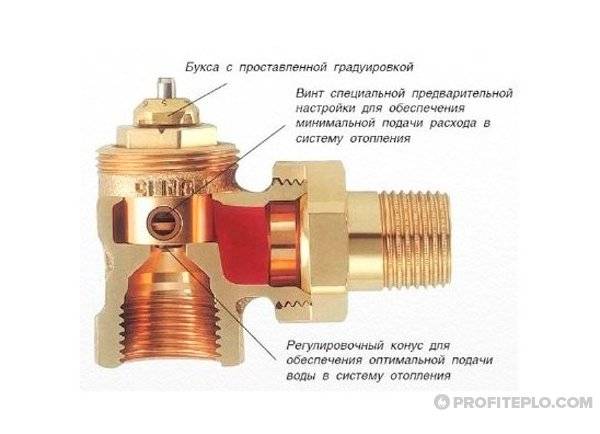

Schematic representation of the Mayevsky crane
Also on the body there is a plastic washer with a hole through which air is released. This requires inserting a screwdriver or key into the recess and turning the cone one turn. When water begins to flow from the hole, the shut-off cone is screwed back in until it stops.
Important! It is recommended to install a valve with a socket for a screwdriver, as the key can get lost. Under no circumstances should the shut-off cone be completely unscrewed - the pressure in the system will not allow it to be restored.
Ball valves: types and parameters
When installing each radiator, it is advisable to put two ball valves or a ball valve for the supply and an adjustment valve for the return. Ball valves are shut-off valves that allow you to shut off the flow of the coolant and dismantle the radiators without draining the coolant from the entire system.
Ball valve device
The key element of the device is a steel ball with a hole for the coolant to pass through. The ball is fixed to the stem, and when the handle is turned 90 degrees, it turns around and completely blocks the flow of the medium.
Ball valves vary
:
- by the material of the body (brass, silumin, polypropylene);
- by design (straight and angular);
- in terms of throughput (for full-bore, the hole in the ball practically coincides with the diameter of the pipe, for standard ones it is 70-80% of this indicator).
Considering which taps are better to put on radiators, preference should be given to full-bore ones, since they do not reduce the throughput of the system and do not reduce the heat transfer of heating devices.
Valves with thermal heads
The thermostatic valve for a heating radiator makes it possible to control the temperature in the room. Depending on the model, the adjustment of the thermal head to a certain temperature is carried out manually or the operation of the valve is flexibly regulated by an automatic device. Under the influence of the thermal head, the valve stem is displaced, changing its flow area.
Thermal head valve
If the installed thermal valve does not have the function of blocking the flow of the coolant, it is additionally required to install a shut-off valve in order to fully service the battery.
Flushing valves
The flush valve on the radiator is designed to drain the coolant during flushing the system. The welded flush valve includes a metal body, rubber gasket, and a long stem. To open such a tap, a gas wrench or pliers are used.
Flush cock
This device has a significant drawback - the rubber gasket is easily destroyed during crane operation, which leads to an emergency. Instead of a welded washer, it is recommended to install a radiator plug or an adapter with a plug valve on the radiator.
Balancing valve
The balancing valve for heating makes it possible to adjust the temperature mode of the heating circuits. If the radiator is not equipped with a thermostatic valve, a mechanical adjustment valve is used, in which the diameter of the flow area is manually set, based on the pressure readings in the pipeline in the sections before and after the valve.
Balancing valve
In systems where the temperature of the batteries is corrected by thermostatic valves, an automatic regulating valve is responsible for balancing the pressure. The balancing control valve is mounted on the return pipe.
Features of installation and maintenance of regulators
Thermoregulator installation diagram
After choosing the optimal model of the thermostat or valve for adjusting the heating temperature, you should perform their correct installation. The location of the reinforcement directly depends on its function and design.
Most often, the regulation components are mounted in the piping of a specific heating radiator. They are installed on the supply pipe or on the bypass. In this case, for comfortable regulation of the temperature of the heating batteries, it is recommended to adhere to the following rules:
- The device should not be covered with decorative panels or other interior items;
- The service life of thermostats largely depends on the quality of the coolant. Therefore, a mesh filter should be installed in front of it, which will protect the valve seat from limescale;
- When installing the heating temperature control valve, follow the installation diagram. On the body of the device, arrows show the direction of movement of the coolant;
- Many thermostats and servos are connected to the mains. Therefore, it is necessary to provide a power supply to them.
Before installing and further adjusting heating batteries in an apartment, you must read the manufacturer's instructions.It prescribes the installation conditions for the operation of a specific control element.
One of the important indicators of apartment heating control valves is the maximum and minimum throughput. They must correspond to the current parameters of the system.


